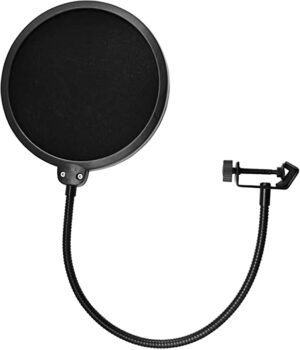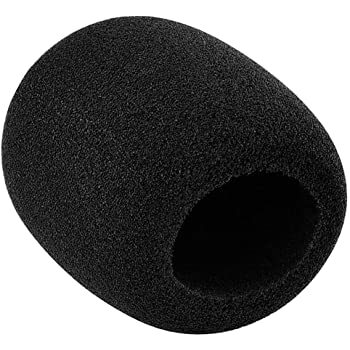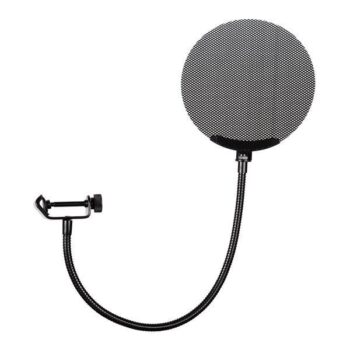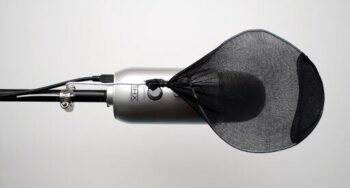How do you know which pop filter to use? It’s easy. This post will explain how to select a pop filter and how to properly use one with voiceovers.
What is a pop filter? It’s a device that goes in front of the microphone to reduce plosives because the less plosives are in your voiceovers, the more professional it will be (anything over 0 is too many).
Contents
Types of Filters
There are three main types of pop filters:
Nylon Mesh
Foam Windscreen
Metal Mesh
Let’s break these down and discuss some details of each.
Nylon Mesh

These pop filters are generally the cheapest, usually costing no more than a lunch out. Make sure to read reviews on the cheap ones, as some models can have clear disadvantages like loose fasteners or loose mesh.
These filters work by ‘absorbing’ air blasts, called plosives, and distributing the air in a wider pattern. Think of it like this: instead of blowing air through a straw, it’s as if you’re blowing the same amount of air through your wide-open mouth. There’s no change in the amount of air coming out, but the air is much less concentrated and less likely to reach the microphone in a ‘hard’ wall.
The downside to this type of filter is they can reduce the high frequencies picked up by the mic. This usually doesn’t cause a huge problem for voiceovers, but your ear may be able to tell the difference. I’ve been using this type of filter for a long time without any issues.
Because this type of filter is mounted at a fixed distance from the mic, it’s easy to keep voiceover consistent. For example, mount the nylon pop filter 2-3 inches from the mic. Now you can stay 3-5 inches from the filter and you’ve got a pretty much perfect distance for voiceovers. No plosives, and no proximity effect.
Pros:
- Cheap to buy
- Easy to keep the same distance from the mic
- Effective
Cons:
- Could possibly reduce the high frequencies
- Some models could be cheaply made and have issues. Read reviews first!
Recommended model: Neewer Nylon Pop Filter on Amazon ![]()
Foam Windscreen

These filters are typically used outdoors by news reporters and filmmakers. You can use these for voiceovers indoors as well, but there are some things to be aware of.
These filters can be extremely effective at reducing plosives if they’re thick enough. They do introduce a major downside, though. Foam filters dull your voice quite a bit. You will definitely be able to hear the difference with a foam filter, so I would advise to stay away from this type of filter unless you’re recording outdoors in a windy environment. That being said, they’re very effective at what they’re designed to do.
One thing to be aware of, is not to be too close to the mic with this type of filter. Reason being that the audio recording will pick up the ‘foam sound’ of your voice if you’re within an inch or two. It will sound like hissing when there’s an F sound, a S, P, or T. To combat this, just back off the microphone by a few inches. With a filter like this, you will likely find yourself subconsciously creeping closer and closer to the mic.
Pros:
- Cheaper than nylon mesh
- Easy to install; can’t move or get bumped
- Very effective at stopping wind noise
Cons:
- ‘Dulls’ your voice by reducing highs
- More difficult to stay back from the mic
- Audible ‘foam sound’ if too close
- Sizes aren’t standardized
Recommended model: Mudder Large Foam Windscreen on Amazon
Metal Mesh

Metal Mesh pop filters are the kings of pop filters. They’re used in studios across the world to eliminate plosives.
The way they work is like this: the air going into the metal mesh is redirected downwards by tiny metal holes that are shaped and angled in such a way that the air is redirected. Now the air won’t hit the ribbon or the capsule of the mic and you won’t hear a massive plosive. These filters also don’t inhibit the frequencies of your voice. Everything that comes from your vocal chords gets to the microphone.
The downside to these models is they’re a little heavier than nylon filters and they cost anywhere from 2x to 4x as much. You’ll be getting quality product, though. If you want top of the line studio quality equipment, the metal mesh pop filter is for you.
Pros:
- Won’t reduce the crispness of your voice
- Studio standard equipment
- Generally high quality
Cons:
- Much more expensive than nylon
- Heavier
Recommended model: Stedman PS101 Metal Mesh Filter on Amazon
Bonus
You can make a nylon pop filter at home 

Use a pair of nylon leggings (needs to be thin, not the yoga pants type) and a wire coat hanger. Untwist the coat hanger and bend it into a circle with a little arm on it. Tightly drape the nylon leggings over the circle and tape it in place. Now tape the arm to your mic stand. BOOM, there’s a cheap home made pop filter (that actually works!).
However, if you don’t have these materials at home already, it will be almost the same price just to buy an entry level nylon mesh pop filter. If you want a fun project, you can get these items:
Recommended supplies: Women’s Leggings on Amazon & Wire Hangers on Amazon
As an Amazon Associate I earn from qualifying purchases. That means I’ll receive a small commission for purchases you make in relation to links you click on this website, but it doesn’t affect the price of the items.
